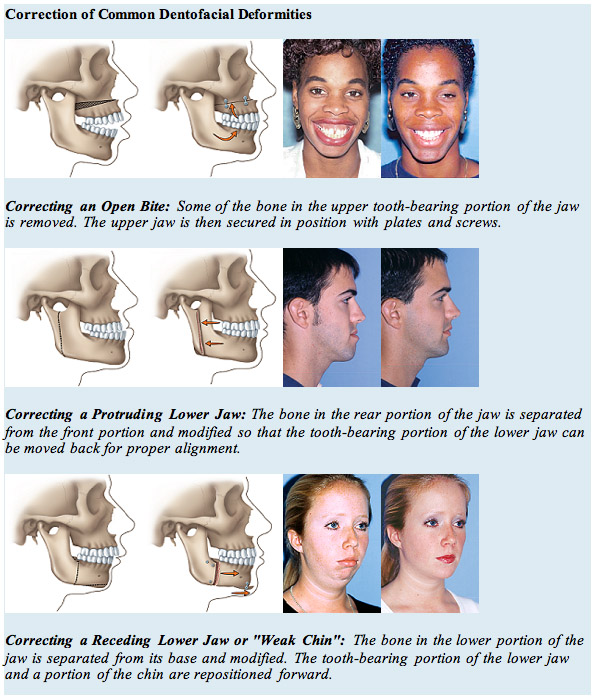Orthognathic Surgery
 Orthognathic, or corrective jaw surgery is performed by Dr. Clark, Dr. Cole, or Dr. Patel to correct a wide range of minor and major skeletal and dental irregularities, including the misalignment of jaws and teeth. A patient’s ability to chew, speak, and breath can be enhanced by correcting the alignment of his or her occlusion. While a patient’s appearance may be enhanced as a result of surgery, orthognathic surgery is performed to correct functional problems.
Orthognathic, or corrective jaw surgery is performed by Dr. Clark, Dr. Cole, or Dr. Patel to correct a wide range of minor and major skeletal and dental irregularities, including the misalignment of jaws and teeth. A patient’s ability to chew, speak, and breath can be enhanced by correcting the alignment of his or her occlusion. While a patient’s appearance may be enhanced as a result of surgery, orthognathic surgery is performed to correct functional problems.
The following are some of the conditions that may indicate the need for corrective jaw surgery:
· difficulty chewing, or biting food
· difficulty swallowing
· open bite (space between the upper and lower teeth when the mouth is closed)
· unbalanced facial appearance from the front, or side
· facial injury or birth defects
· deficient chin
· protruding jaw
· inability to make the lips meet without straining
· chronic mouth breathing and dry mouth
· sleep apnea (breathing problems when sleeping, including snoring)
· excessive show of gums while smiling
Who benefits from Corrective Jaw Surgery?
Patients who may benefit from corrective jaw surgery include those with an improper bite resulting from misaligned teeth and jaws. In some cases, the upper and lower jaws may grow at different rates. Injuries and birth defects may also affect jaw alignment. While orthodontics can usually correct the misalignment of teeth, corrective jaw surgery is necessary to correct the misalignment of the jaws.
Evaluating Your Need for Corrective Jaw Surgery
Dr. Clark, Dr. Cole, or Dr. Patel, along with your dentist and orthodontist, will work together to determine whether you are a candidate for corrective jaw, or orthognathic, surgery. While Dr. Clark, Dr. Cole, or Dr. Patel will determine which corrective jaw surgical procedure is appropriate and will perform the actual surgery, it will be up to your orthodontist to align your teeth prior to and following surgery. It is important to understand that your treatment may take several years to complete. Dr. Clark, Dr. Cole, and Dr. Patel, along with your orthodontist understand that this is a long-term commitment for you and your family, and we will try to estimate the time required for your treatment.
Corrective jaw surgery may reposition all or part of the upper jaw, lower jaw, and chin. When you are fully informed about your case and your treatment options, you and your dental team will determine the course of treatment that is best for you.
What Is Involved in Corrective Jaw Surgery?
Before your surgery, orthodontic braces move your teeth into a new position. Because your teeth are being moved into a position that will fit together after surgery, you may at first think your bite is actually getting worse rather than better. However, once Dr. Clark, Dr. Cole, or Dr. Patel reposition your jaws with surgery, your teeth should fit together properly.
As your pre-surgical orthodontic treatment nears completion, additional or updated records, including x-rays, pictures and models of your teeth, may be taken to help guide your surgery.
Dr. Clark, Dr. Cole, or Dr. Patel will reposition the jawbones in accordance with your specific needs. In some cases, bone may be added, taken away or reshaped. Surgical plates, screws, wires and rubber bands may be used to hold your jaws in their new positions. Incisions are usually made inside the mouth to reduce visible scarring; however, some cases do require small incisions outside of the mouth. When this is necessary, care is taken to minimize their appearance. Most procedures are performed at St. John’s Regional Medical Center and require that you spend a few nights in the hospital.
After surgery, we will provide instructions for a modified diet, which may include solids and liquids, as well as a schedule for transitioning to a normal diet. Pain following corrective jaw surgery is controlled with medication, and patients are generally able to return to work or school from two to three weeks after surgery. While the initial healing phase is about six weeks, complete healing of the jaws takes between three to six months.
Enjoy the Benefits
Corrective jaw surgery moves your teeth and jaws into positions that are more balanced, functional and healthy. Although the goal of this surgery is to improve your bite and function, some patients also experience enhancements to their appearance and speech. The results of corrective jaw surgery can have a dramatic and positive effect on many aspects of your life. So make the most of the new you!
